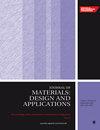基于银-铜-钛 + W-AlN/Mo 箔/铌箔中间膜的 B4C/TC4 钎焊接头的界面微观结构和力学性能
IF 2.2
4区 材料科学
Q3 MATERIALS SCIENCE, MULTIDISCIPLINARY
Proceedings of the Institution of Mechanical Engineers, Part L: Journal of Materials: Design and Applications
Pub Date : 2024-05-31
DOI:10.1177/14644207241258047
引用次数: 0
摘要
研究了使用 AgCuTi-AlN-W + Mo 箔 + Nb 箔钎焊填料钎焊的碳化硼(B4C)和钛合金(TC4)接头的微观结构和形成机理。讨论了 W/AlN 含量对接头微观结构和机械性能的影响。为了减轻残余热应力,加入了难熔金属箔,如 Mo/Nb 箔。与普通复合夹层相比,通过 AgCuTi-AlN-W + Mo 箔 + Nb 箔原位合金化形成的夹层具有更多、更细的增强相,同时不会降低填充材料的活性。韧性好的钼/铌箔通过弹性变形来适应较大的应变失配。相邻材料和夹层之间的界面结合良好,没有出现任何裂缝。最有效的体系是镀镍 B4C + Mo 箔 + AgCuTi-3 wt% AlN-5 wt% W + AgCu 箔 + Nb 箔 + TC4,其剪切强度最高,约为 115 兆帕。本文章由计算机程序翻译,如有差异,请以英文原文为准。
Interfacial microstructure and mechanical properties of B4C/TC4 brazed joints based on Ag-Cu-Ti + W-AlN/Mo foil/Nb foil interlayer
The microstructure and formation mechanism of the boron carbide (B4 C) and titanium alloy (TC4) joints brazed with AgCuTi-AlN-W + Mo foil + Nb foil brazing filler were investigated. The effects of W/AlN content on microstructure and mechanical properties of the joints were discussed. To alleviate residual thermal stress, refractory metal foils such as Mo/Nb foils were added. Compared with the common composite interlayers, the interlayer formed via AgCuTi-AlN-W + Mo foil + Nb foil in-situ alloying had more and finer reinforcing phases without reducing the activity of the filler material. The ductile Mo/Nb foils contributed to accommodate the large strain mismatch by elastic deformation. The interfaces between the adjoining materials and the interlayer were well-bonded without any cracks. The most effective system was nickel-plated B4 C + Mo foil + AgCuTi-3 wt% AlN-5 wt% W + AgCu foil + Nb foil + TC4, which exhibited the highest shear strength of approximately 115 MPa.
求助全文
通过发布文献求助,成功后即可免费获取论文全文。
去求助
来源期刊

CiteScore
4.70
自引率
8.30%
发文量
166
审稿时长
3 months
期刊介绍:
The Journal of Materials: Design and Applications covers the usage and design of materials for application in an engineering context. The materials covered include metals, ceramics, and composites, as well as engineering polymers.
"The Journal of Materials Design and Applications is dedicated to publishing papers of the highest quality, in a timely fashion, covering a variety of important areas in materials technology. The Journal''s publishers have a wealth of publishing expertise and ensure that authors are given exemplary service. Every attention is given to publishing the papers as quickly as possible. The Journal has an excellent international reputation, with a corresponding international Editorial Board from a large number of different materials areas and disciplines advising the Editor." Professor Bill Banks - University of Strathclyde, UK
This journal is a member of the Committee on Publication Ethics (COPE).
 求助内容:
求助内容: 应助结果提醒方式:
应助结果提醒方式:


